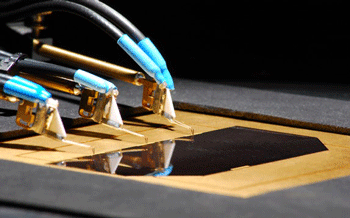- News
25 November 2011
Fraunhofer ISE and Azur Space extend cooperation on developing space-based III-V solar cells
After more than 15 years of cooperating on the development and production of multi-junction solar cells based on III-V semiconductors, the strategic partnership between Fraunhofer Institute for Solar Energy Systems ISE and Azur Space Solar Power GmbH of Heilbronn, Germany has now been confirmed for the next 20 years by signing a further cooperation agreement. In the coming years, Fraunhofer ISE will work exclusively with Azur Space on new generations of solar cells for applications in space.
 Picture: Measuring a cell’s calibrated current-voltage characteristic using a multi-source solar simulator. ©Fraunhofer ISE.
Picture: Measuring a cell’s calibrated current-voltage characteristic using a multi-source solar simulator. ©Fraunhofer ISE.
Fraunhofer ISE says that, of all solar cells to date, the highest efficiencies for converting sunlight into electricity are achieved by multi-junction solar cells based on III-V semiconductors (typically gallium arsenide, aluminum gallium arsenide,and gallium indium phosphide). In contrast to silicon, III-Vs can be optimized to match specific wavelength ranges in the solar spectrum by precisely adjusting the atomic compositions. To produce a multi-junction solar cell, several III-V-based solar cells, each of which absorbs a different part of the solar spectrum from the blue to infrared range, are monolithically stacked on top of each other. The cells are internally series connected by tunnel diodes. The resulting stack can consist of up to 40 single layers.
Due to the layering principle of the subcells and the high crystalline quality of the III-V materials used, multi-junction solar cells currently achieve the highest conversion efficiencies. In space, efficiencies of triple-junction cells are about 30%. III-V cells have been used to power satellites since 1995. However, the potential for this application has not yet been exhausted, says Fraunhofer ISE.
In the future, III-V solar cells are expected to generate more electricity per cell area, weigh less and be more robust so that they can better withstand the highly charged particles encountered in orbit. Together with Azur Space, the researchers in Freiburg are addressing these aims and developing manufacturing processes for next-generation multi-junction solar cells. The work is supported by the European Space Agency (ESA-ESTEC), the German Aerospace Center (DLR), and the German Federal Ministry of Education and Research (BMBF).
Research results are being implemented in the products of Azur Space. “The manufacturing process developed at Fraunhofer ISE for multi-junction solar cells serves as the basis for the industry production carried out today by Azur Space Solar Power,” says Fraunhofer ISE deputy director Dr Andreas Bett, who is also ‘Materials – Solar Cells and Technology’ division director. “It is the long-standing successful cooperation with Fraunhofer ISE that has made Azur Space a worldwide leader in manufacturing III-V solar cells,” believes Azur Space’s CEO Dr Klaus-Dieter Rasch.
Azur Space Multi-junction solar cells
